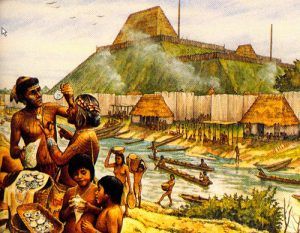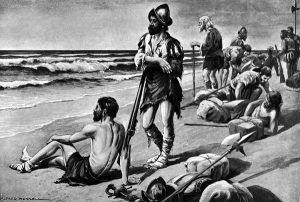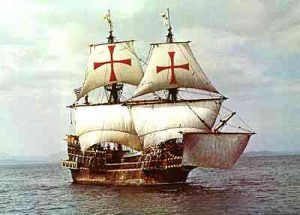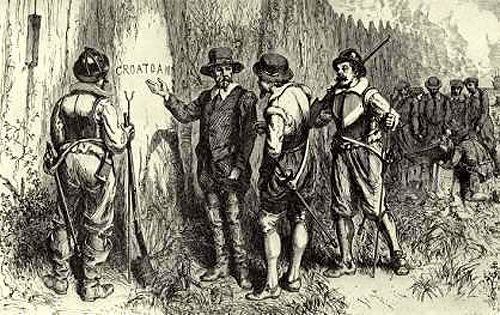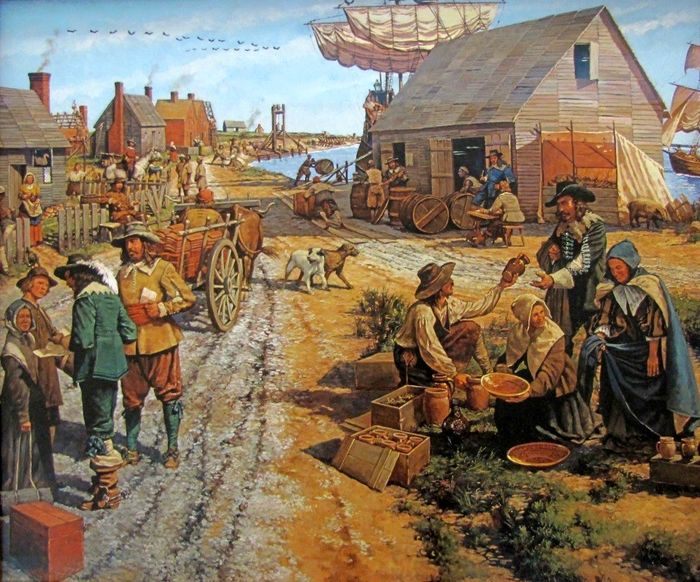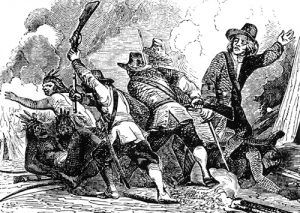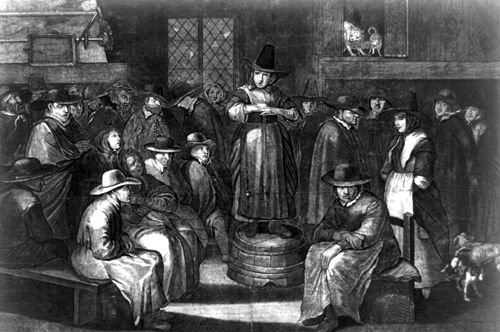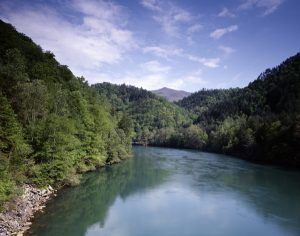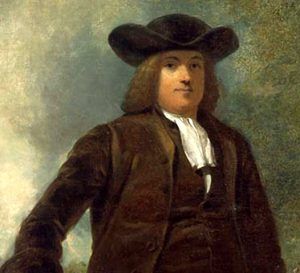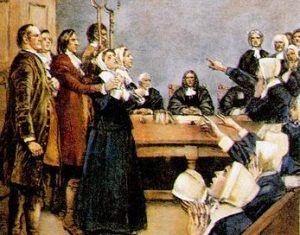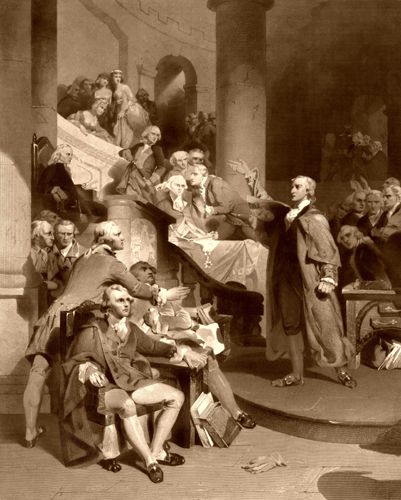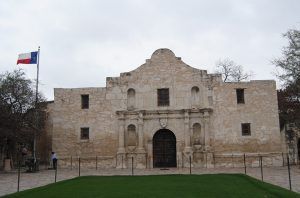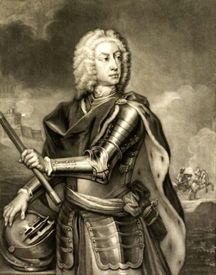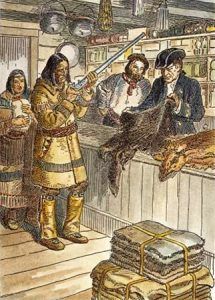This Pre-United States history timeline includes the first inhabitants of what was now the United States, the colonial settlers, and the events that led to the American Revolution.
The United States was first inhabited by Asian nomads who crossed the Bering Land Bridge in present-day Alaska thousands of years before Europeans discovered the continent.
Many years later, Europeans began to explored the continent, and soon, settlers began to live in this vast land, eventually establishing what the United States of America was.
Pre-United States History Timeline
16,000 – 8,000 BC – Paleoindian hunter-gatherers migrated across the Bering land-and-ice bridge between Siberia and Alaska.
13,500 BC to 11,000 BC – The Clovis Culture began in North America. The era was named for distinct stone tools found near Clovis, New Mexico.
3,000 BC to 1000 AD – The Woodland Period began in Eastern America.
986 AD – Norsemen settled in Greenland and saw the coast of North America but didn’t land.
1000 to 1520 AD – The Mississippian culture began in North America.
1001 – Leif Ericson explored North America.
c. 1100 – Oraibi, a Hopi village in Navajo County, Arizona, was settled sometime before this time, making it one of the oldest continuously inhabited settlements within the United States.
c. 1100-1200 – Cahokia, Illinois, near modern-day St. Louis, Missouri, reached its peak population.
c. 1190 – Construction began on the Cliff Palace by Ancestral Puebloans in modern-day Colorado.
1492 – Christopher Columbus discovered America.
1497 – John Cabot claimed North America for England.
1507 – A new world map by Martin Waldseemuller named the New World “America” continents in honor of Amerigo Vespucci.
1508 – First European colony and oldest known European settlement in a United States territory were founded at Caparra, Puerto Rico, by Ponce de Leon.
1513 – Vasco Núñez de Balboa crossed the isthmus of Panama and saw the Pacific Ocean.
1519 – Ferdinand Magellan was the first to go around the world
Alonzo de Pineda explored the Gulf Coast of America
1524 – Giovanni da Verrazzano, working for France, explored the coastline from present-day Maine to North Carolina.
1528 – Panfilo de Narvaez conquered Cuba and explored Florida.
Alvar Cabeza de Vaca explored Texas, Arizona, and New Mexico.
1534 – Jacques Cartier explored the Great Lakes and the St. Lawrence River and claimed modern Quebec, Canada, for France.
1539 – Hernando de Soto explored south-eastern North America.
1540 – Francisco Vasquez de Coronado explored south-western North America
Discovery of the Grand Canyon by Garcia Lopez de Cardenas
Pedro de Tovar comes in contact with the Hopi people at Oraibi as part of the expedition led by Francisco Vasquez de Coronado.
1541 – Hernando de Soto discovered the Mississippi River, strengthening Spanish claims to North America’s interior.
Explorer Juan Ponce de León of Spain landed on the coast of Florida.

Francisco Vasquez de Coronado
Francisco Vasquez de Coronado explored Kansas.
1542 – Juan Rodríguez Cabrillo discovered and explored the Californian coast.
1559 – Tristan de Luna explored North America.
1562 – Jean Ribault left France with 150 colonists for the New World, establishing Charlesfort on Parris Island in South Carolina, abandoned several years later.
1563 – Francisco de Ibarra explored New Mexico.
1564 – French Fort Caroline was established on the banks of the St. Johns River, Florida. Pedro Menéndez de Avilés sacked the fort in 1565.
1565 – Admiral Pedro Menéndez de Avilés founded St. Augustine, Florida, the earliest successful Spanish/European settlement in the future continental United States.
1570s – The Iroquois Confederacy was founded.
1576 – Sir Martin Frobisher explored Baffin Bay and the Hudson Strait.
1577 – Sir Francis Drake circumnavigates the world from December 13, 1577, to September 26, 1580.
1579 – Francis Drake claims California’s lands for England and Queen Elizabeth I, landing in Drake’s Bay and naming it New Albion.
1584 – Philip Amadas and Arthur Barlowe, who were in the service of Sir Walter Raleigh, explored the coast of North Carolina.
March 25, 1585 – Sir Walter Raleigh received the patent to explore and settle in North America.
June 1585 – Walter Raleigh’s fleet of seven vessels under Richard Grenville and Ralph Lane, with 108 men, reached Roanoke Island, North Carolina.
June 4, 1585 – Virginia colony of Roanoke Island was established by Walter Raleigh.
1587 – Virginia Dare was born in Roanoke, making her the first known English child born in the New World.
The first Asians to set foot in the United States were Filipino sailors who arrived on Spanish ships at Morro Bay, California.
1588 – The first battle of the English against the Spanish Armada began, leading to their defeat, and the lessening of Spain’s influence in the New World and the rise of English influence in the Americas.
1590 – Roanoke Colony found deserted.
1598 – Juan de Archuleta explored Colorado.
1602 – Captain Bartholomew Gosnold was the first Englishman to land on the New England coast, exploring and naming Cape Cod and Martha’s Vineyard.
1605 – The first capital of French Acadia was established as Port-Royal in modern-day Nova Scotia; it lasted until 1613.
George Weymouth explored New England.
1606 – The joint-stock company Virginia Company of London was founded and granted a Royal Charter by James I to settle in the New World.
1607 – Captain John Smith leads colonists to establish Jamestown, Virginia, the Americas’ first permanent English settlement.
The Virginia Company of Plymouth founded the short-lived Popham Colony in Maine.
1608 – Quebec, Canada, was founded by Samuel de Champlain.
1609 – Henry Hudson explored the Hudson River and Delaware Bay for the Dutch.
1609-10 – These years were known as the Starving Time at Jamestown, Virginia.
1610 – Santa Fe, New Mexico, was established by Spain.
1612 – The Dutch established a fur trading center with the Native Americans on Manhattan Island.
1614 – The Dutch claimed New Netherland. It was located on the east coast of America, including New York, New Jersey, Delaware, and Connecticut, with small outposts in Pennsylvania and Rhode Island.
John Rolfe successfully harvests tobacco in Jamestown, Virginia, ensuring the colony’s success.
1617-19 – Smallpox killed roughly 90% of the Massachusetts Bay Indians.
1619 – The first African Americans were brought to Jamestown, beginning the practice of slavery in the Virginia colony.
The House of Burgesses was formed in Jamestown, English North America’s first democratically elected legislative body.
1620 – The Mayflower Compact was signed, and the Plymouth Company founded the colony in what would become Massachusetts.
1622 – Indian massacre of 1622 in Virginia.
1624 – King James I revokes the Virginia Company’s charter, and Virginia becomes a royal colony.
New Amsterdam was founded by the Dutch West India Company, later renamed New York.
1628 – Massachusetts Bay Colony founded.
1630 – Boston, Massachusetts, was founded.
1632 – The Province of Maryland was founded.
1636 – The first university in the colonies was founded — Harvard College.
Thomas Hooker founded the Connecticut Colony.
Roger Williams founded the Colony of Rhode Island and Providence Plantations.
The Pequot War began in New England in July 1636 and lasted through September 21, 1638.
1637 – The New Haven Colony was founded in present-day Connecticut.
New Sweden was established around the southern Delaware River by Peter Minuit.
1639 – The New Haven Colony Fundamental Agreement was signed and officially adopted.
The English Crown formally recognized the Virginia Assembly.
1640 – The French and Iroquois Wars escalated to full warfare.
1652 – Rhode Island enacted the first law declaring slavery illegal.
1656 – First Quakers arrived in New England.
1655 – The Peach Tree War was a large-scale attack on September 15, 1655, by the Susquehannock Indians and allied tribes on several New Netherland settlements along the Hudson River in New York.
1659-1663 – Esopus Wars were two conflicts between the Esopus tribe of Lenape Indians (Delaware) and New Netherland colonists.
1663 – King Charles II grants a charter for a new colony — the Province of Carolina.
1664 – New Amsterdam was captured by the English at the start of the Second Anglo-Dutch War.
New Jersey and New York were established as the Proprietary Colonies of England.
1667 – New Netherland was ceded to England under the Treaty of Breda.
1669 – The Fundamental Constitutions of Carolina were drawn up.
1669-1670 – John Lederer of Virginia explored the Appalachian Mountains.
1670 – Charles Town (Charleston) was founded in present-day South Carolina.
1672-73 – Louis Jolliet and Jacques Marquette explored the Illinois Country.
1675-76 – King Philip’s War was fought in New England between natives and colonists.
1676 – Bacon’s Rebellion occurred in Virginia against the rule of Governor William Berkeley.
1677 – Colonists in North Carolina rebelled against ruling governor Thomas Colepeper.
Edmund Andros, Governor of New York, negotiated the Covenant Chain with the Iroquois.
The Province of Maine was absorbed by the Massachusetts Bay Colony.
1679 – The war between the Westo tribe and colonial South Carolina destroyed the Westo.
The Province of New Hampshire was created out of the Massachusetts Bay Colony by royal decree from King Charles II.
1681 – William Penn received a royal charter from King Charles II to establish Pennsylvania.
1682 – René-Robert Cavelier, Sieur de La Salle, explored the Ohio River Valley and the Mississippi River Valley. He claimed the entire territory of France as far south as the Gulf of Mexico.
William Penn published “Frame of Government of Pennsylvania” and founded Philadelphia.
1685 – Fort St. Louis (French colonization of Texas) was established near Arenosa Creek on Matagorda Bay by French explorer Robert Cavelier de La Salle; the fort was abandoned in 1688.
1686 – Henri de Tonti established the Arkansas Post as the first European settlement in the lower Mississippi River Valley.
1688-97 – King William’s War was fought between New France and New England and their respective Indian allies.
1689 – The Boston Revolt and Leisler’s Rebellion.
Parliament passed the Toleration Act of 1688, which gave limited Freedom of Religion to all British citizens.
1690 – Spanish authorities, concerned that France posed a competitive threat, constructed several missions in East Texas.
1692 – Salem Witch Trials occurred in Massachusetts.
1696 – Cahokia, Illinois, was established by French missionaries from Quebec, Canada, and was one of the region’s earliest permanent settlements.
1699 – The capital of Virginia was moved from Jamestown to Williamsburg, and Jamestown was slowly abandoned.
Free African Americans were ordered to leave the Colony of Virginia.
1700 – José Romo de Vivar becomes one of the earliest Spanish settlers in present-day Arizona.
1701 – The Collegiate School at Saybrook was founded in Connecticut. It will later be renamed Yale College.
The Delaware Colony was granted a charter, separating it from Pennsylvania.
1702 – East Jersey and West Jersey became crown colonies.
Mobile, Alabama, was founded.
1703 – Kaskaskia, Illinois, was established as a small mission station for the French.
1705 – The House of Burgesses passed the Virginia Slave Codes.
1706 – Albuquerque, New Mexico, was founded and named for the viceroy of New Spain, Francisco Fernández de la Cueva, 10th Duke of Alburquerque.
1710 – Francis Nicholson takes Port Royal.
1711-15 – North Carolina fought the Tuscarora War with the Tuscarora people.
1712 – Carolina colony was divided into North and South Carolina.
New York Slave Revolt of 1712.
1713 – The Treaty of Utrecht was signed, ending Queen Anne’s War, the second in a series of French and Indian Wars.
1714 – Louis Juchereau de St. Denis established Natchitoches, the oldest permanent European settlement in present-day Louisiana.
1715 – The Yamasee War began in South Carolina.
1718 – Mission San Antonio de Valero (The Alamo) was built as the first Spanish mission along the San Antonio River.
The French found New Orleans, Louisiana.
Blackbeard, the pirate, was killed in battle by Lieutenant Robert Maynard in the waters off of the Province of North Carolina.
1722 – Father Rale’s War, also known as Dummer’s War, began. This was a series of battles between New England and the Wabanaki Confederacy, allied with New France. It lasts until 1725.
1723 – The Colony of Virginia passed an act to deal with slave conspiracies.
The French established Fort Orleans along the Missouri River near Brunswick, Missouri.
1729 – The Province of Carolina proprietors sell out to the Crown.
The city of Baltimore, Maryland, was founded.
1732 – General James Oglethorpe founded the Province of Georgia.
1739 – The Stono Rebellion, a slave revolt in the Province of South Carolina, was crushed.
1740 – The Plantation Act was passed to encourage immigration to the colonies.
James Oglethorpe failed to take St. Augustine, Florida.
South Carolina enacted the Negro Act that made it illegal for slaves to move abroad, assemble in groups, raise food, earn money, and learn to write English.
1741 – The New York Conspiracy was suppressed. This was a plot by slaves and poor whites in New York to revolt and level New York City with fires.
1744 – King George’s War, the third of the four French and Indian Wars, began. It lasts until 1748.
The mail-order catalog was conceptualized and invented by Benjamin Franklin.
1746 – Princeton University in present-day New Jersey was founded.
1747 – Englishmen and Virginians founded the Ohio Company to promote trade with Native American tribes and secure English control of the Ohio River Valley.
1749 – The Province of Georgia overturns its ban on slavery.
c. 1750 – The population of the Thirteen Colonies was roughly 1.5 million.
1750 – Thomas Walker passed through the Cumberland Gap.
1754 – The French and Indian War began and lasted until 1763.
Columbia University was founded as King’s College in present-day New York City.
1758 – The first black Baptist church was founded in Lunenburg, Virginia.
1760 – A huge fire destroyed much of Boston, Massachusetts.
February 10, 1763 – The Treaty of Paris ends the French and Indian War (1754-1763). Canada east of the Mississippi River was added to the British empire.
Pontiac’s Rebellion against the British began and lasted until 1766.
October 7, 1763 – The Proclamation of 1763, issued by King George III after the French and Indian War, organized the North American empire and stabilized relations with Native Americans. No British settlements were allowed west of the Appalachian Mountains, and settlers in these areas had to return east.
Next – American Revolution Timeline 1764 – 1783
Compiled and edited by Kathy Alexander/Legends of America, updated March 2024.
Also See:
American History Photo Galleries
Settling of America – New England Settlements
Sources:



